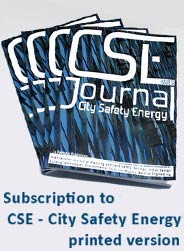Safety in urban environment
Abstract
Two are the words of English language to convey the feeling of protection against threats: security and safety. Security expresses the reaction to social problems, typically the fear of personal attacks. It is highly perceived as a priority for the liveability of urban environment, especially from the elderly.
Safety is the word used in the copious literature about risk assessment and mitigation, for conveying threats related to natural and man-made hazards. Whereas security is rather a result of social structure of our societies, nevertheless ITC devices are largely used to improve the feeling of being secure, namely the video surveillance systems.
Several disciplines deal with the complex topic of safety, as it touches most of our daily activities and scientific subjects: structural design, physical planning, road design, transportation engineering, geotechnical and hydraulic engineering, etc.. Being one of the key words of our review, it is unnecessary to underline
the relevance of the topic being offered to the readers.
Less evident can be the relations between natural and manmade hazards and the urban schemes. The technologically advanced societies are facing growing challenges due to the increasing complexity of communities, whereas the poor
countries are always suffering from the heavy economic losses, unbearable in a low income society.
From the outcomes of natural and man-made hazards on the world economy, hence the urgency for decision makers to allocate a growing part of the ever scarcer economic resources to risk mitigation.
The Global Platform for disaster risk reduction, held in Geneva in 2013 (DRR Report), found that the global economy’s transformation over the last 40 years has led to a growing accumulation of disaster risk. Annually, economic losses already amount to hundreds of billions of dollars and they are projected to double by 2030. Countless everyday local events and chronic stresses involving multiple risks are an ongoing burden for many communities. (…) Urban risk needs to be more fully understood.
The risk of failures in technical systems also poses severe consequences that have often been overlooked. The dynamic and multidimensional aspects of risk require holistic and comparable methodologies for risk assessment to enable, science-based decision-making and identification of development opportunities.
Moreover, disasters happen locally and solutions are to be found locally. This does not relieve national governments of their responsibilities to establish a framework and enabling environment for local action. However, municipalities and local authorities are in unique positions to lead and create opportunities for local partnerships and to take risk-informed decisions that protect the continued potential for economic and social development. Sound urban development and spatial planning, including attention to informal settlements, migration, safe housing, infrastructure and social services, are crucial. Focus was also placed by the Platform on efforts to ensure that all schools and hospitals are built to resilient standards, that all necessary school and hospital preparedness measures are in place and that attention has been given to the needs of persons with disabilities. ...(View PDF to read all Editorial)
Read the full text
Download PDFReferences
Caldaretti S., Fabietti W. e Riggio A. (1987), La vulnerabilità sismica dei sistemi territoriali, Dei, Roma.
Campo G. (1996), “Una ‘città sicura’ per il rilancio della pianificazione”, Urbanistica informazioni, 146: 51-54.
Fabietti W. (1999), Vulnerabilità e trasformazione dello spazio urbano, Alinea, Firenze.
Fanelli C. et alii (1993), “Percezione del rischio e atteggiamenti sull’uso dell’energia nucleare e di altre fonti di energia”, Prevenzione
oggi, 3: 45-89.
Fiorelli F. (1988), “Dissesto naturale, rischio sismico e pianificazione territoriale”, in Mura P.M. (ed.), Una geografia per la pianificazione,
Gangemi, Roma.
Foster H.D. (1980), Disaster Planning: the preservation of life and property, Springer, New York.
Foucher M. (1982), ‘Esquisse d’une géographie humaine des risques naturels’, Herodote, 24/25, numero speciale “Terres à
hauts risques”.
Imbesi G. (1997), “Presentazione: fratello terremoto”, in Tira M. (1997), Pianificare la città sicura, Edizioni Librerie Dedalo,
Roma.
Menoni S. and Margottini C. (2011), Inside risk: a strategy for sustainable risk mitigation, Springer Verlag.
Tira M. (1994), “I riferimenti normativi ordinari per la pianificazione urbanistica in zone sismiche”, L’Ufficio tecnico, Maggioli,
Rimini, 7/8: 949-979.
Tira M. (1997), “Città e sicurezza: una sfida per la pianificazione”, in Bertuglia C.S. e Vaio F. (eds), La città e le sue scienze (Vol.
IV: Le metodologie delle scienze della città), Franco Angeli, Milano.
Tira M. (1997), Pianificare la città sicura, Edizioni Librerie Dedalo, Roma.
Tiboni M. e Tira M. (1999), “Urban policies and techniques towards a safer town”, Proceedings della IV International Conference
“Energy, Environment and Technological Innovation”, Roma, Vol. II, pp. 953-957.
Tira M., Tiboni M. e Badiani B. (2001), “Planning land use transformations to reduce natural risks: a case study in Liguria (Italy)”,
Proceedings of the Colloque International : Risques et territoires (Lyon 2001), CERTU-CNRS.
Tira M and Zazzi M. (eds.) (2012), “Pianificazione Territoriale e difesa del Suolo. Quarant’anni dopo la relazione De Marchi”,
Gangemi, Roma.
Varnes D.J. & IAEG Commission on landslides (1984), Landslide hazard zonation. A review of principles and practices, UNESCO,
Paris.
DOI: http://dx.doi.org/10.12896/cse20150010065
Refbacks
- There are currently no refbacks.

This work is licensed under a Creative Commons Attribution 3.0 License.
CSE Journal - City Safety Energy is a semiannual journal (Two ISSUES per Year) published by Le Penseur in Brienza (PZ) - Italy | ISSN print edition 2283-8767 | ISSN online edition 2284-3418 - Journal registerd at the Court of Potenza (Italy) n. 219/2014


